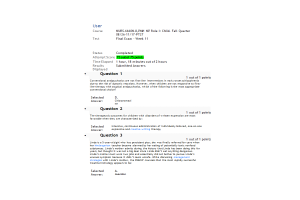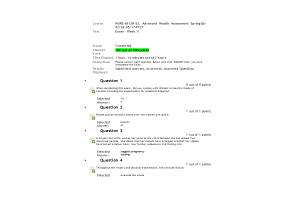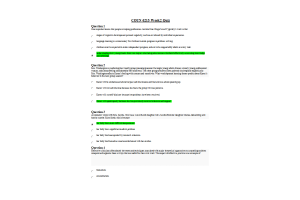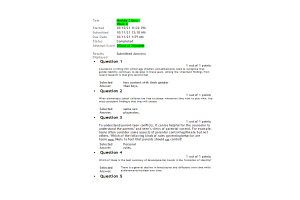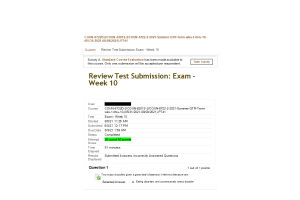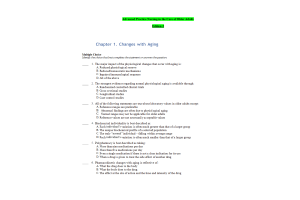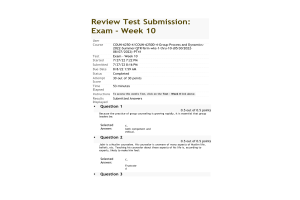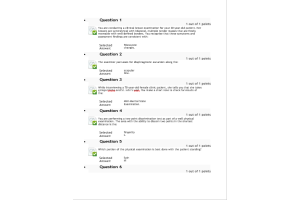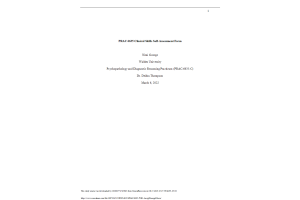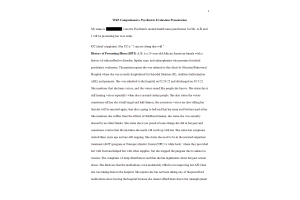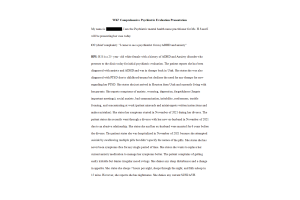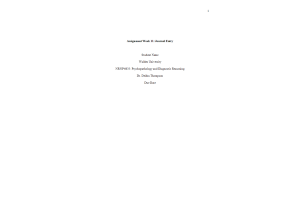NRNP 6635 Week 11 Final Exam
- $49.00
- Question: Select the mental function that is most affected in mild cognitive impairment.
- Question: Select the most frequent cause of infant and childhood intellectual disability that is attributed to a specific gene.
- Question: Select the neurotransmitter that is most associated with the occurrence of ADHD.
- Question: Select the drug of choice to treat psychosis in delirious patients.
- Question: Select the characteristic that is greater in childhood than adult onset schizophrenia.
- Question: Select the personality disorder in which patients are continually in crisis and exhibit unpredictable behavior.
- Question: Select the factor that best correlates with attempted and completed suicide.
- Question: Select the brain region that shows the greatest anatomical abnormalities in schizophrenic patients.
- Question: Select the gender dysphoria in which genital surgery is usually not chosen.
- Question: Select the antipsychotic drug for which the labeling carries a black box warning for agranulocytosis.
- Question: Select the time of onset for tolerance to develop from continuous use of hallucinogens such as LSD.
- Question: Select the most reliable method to make a diagnosis of schizophrenia.
- Question: Select the dysfunction that is common to 50% to 85% of schizophrenic patients.
- Question: Select two of the “Four A’s” symptoms of schizophrenia described by
- Question: Select the personality disorder in which patients exhibit covert obstructionism, procrastination and pessimism.
- Question: Select the negative symptom of schizophrenia.
- Question: Select the main cause female orgasmic disorder.
- Question: Select the age range for 90% of patients treated for schizophrenia.
- Question: Select the non-drug therapy in which mastery of anxiety through desensitization is critical to successful treatment of sexual dysfunction.
- Question: Select the disorder that is often comorbid with brief psychotic disorder.
- Question: Select the psychoactive substance that is most frequently consumed worldwide.
- Question: Select the age range at which most children with gender dysphoria begin to show increased anxiety over anticipated changes to their bodies.
- Question: Select the theorist who first studied social and cultural influences on suicide.
- Question: Select the disorder in which is characterized by lack breast development.
- Question: Select the age range of the highest rate of substance dependence or abuse.
- Question; Select two terms preferred to describe sexual orientation
- Question; Select the two patient populations in which delirium occurs most frequently.
- Question: Select the drug used to treat neuroleptic malignant syndrome.
- Question; Select the drug that is most likely to cause parkinsonian movement symptoms.
- Question: Select the two main conditions to initially identify in adult psychiatric emergencies.
- Question: Select the psychiatric emergency that is indicated by mothers who express inadequate distress over their children’s medical symptoms.
- Question: Select the drug that is least life-threatening when consumed in an overdose.
- Question: Select the drug that is safe and effective in treating mild to moderate memory loss in early Alzheimer’s disease.
- Question: Select the substance that is most commonly abused by adolescents.
- Question: Select the development time of symptoms in neuroleptic malignant syndrome.
- Question: Select the patient population at most risk of mortality from delirium.
- Question: Select the most distinguishing characteristic of delirium.
- Question: Select the category of symptoms that is most commonly comorbid with cognitive disorders.
- Question: Select the primary defense mechanism that is common in delusional disorder.
- Question: Select the neurotransmitter system that is most associated with the addictive rewarding properties of opioids.
- Question: Select the type of hallucinations most common in schizophrenia.
- Question: Select the diagnostic criterion for catatonia resulting from a medical condition.
- Question: Select the two factors that are not applicable to diagnosing schizoaffective disorder.
- Select the percentage of substance-addicted persons with a concurrent psychiatric disorder.
- Question: Select the hepatic enzyme that performs the initial metabolism of alcohol.
- Question: Select the epidemiologic characteristic of tardive dyskinesia symptoms.
- Question: Select the neurotransmitter that inhibits sexual orgasm.
- Question: Select the drug that is least likely to cause male sexual dysfunction.
- Question: Select the youngest age at which childhood-onset schizophrenia can be distinguished from autism spectrum.
- Question: Select the most effective form of questioning when taking a sex history.
- Question: Select the initial intervention to treat children experiencing acute school refusal.
- Question: Select the primary method to assess cognition.
- Question: Select the preferred drug used to treat alcohol withdrawal.
- Question: Select the procedure most applicable to confirming a diagnosis of delirium.
- Question: Select the brain region that is associated with substance addiction.
- Question: Select the two defense mechanisms used commonly by patients with personality disorders.
- Question: Select the lifetime prevalence of schizophrenia in the United States.
- Question: Select the subtype of schizophrenia in which auditory hallucinations are frequent.
- Question: Select the neurotransmitter deficiency that is most associated with delirium.
- Question: Select the rating scale used to assess medication-induced movement disorders.
- Question: Select the symptom not present in paranoid personality disorder.
- Select the percentage range of schizophrenic patients that remain significantly impaired throughout their lives
- Question: Select the drug most likely to inhibit female orgasm.
- Question: Select the two non-drug therapies most likely to be effective in treating paraphilic disorders.
- Question: Select the two patient populations most likely suffer neuroleptic-induced parkinsonian symptoms.
- Question: Select the factor that is most influential in determining gender role development.
- Question: Select the most common paraphilic disorder.
- Question: Select the therapy that is contrary to position statements of the American Academy of Child and Adolescent Psychiatry.
- Question: Select the psychiatric disorder in which patients refuse mental health care and deny their problems.
- Question: Select the most common cause of dementia in elderly persons.
- Question: Select the substance of abuse with the strongest evidence for genetic association.
- Question: Select the characteristic found in persons with intersex conditions.
- Question: Select the medical condition in which erectile dysfunction drugs (e.g., sildenafil) are likely to be ineffective.
- Question: Select the neurotransmitter that increases sexual desire.
- Question: Select the infectious disease that when untreated may lead to an incorrect diagnosis of depression.
- Question: Select the two essential features of sexual dysfunction.
- Question: Select the personality disorder in which patients seek social withdrawal.
- Question: Select the percentage of the U.S. population with a substance dependence problem as of year 2012.
- Question: Select the youngest age by which early-onset schizophrenia occurs.
- Question: Select two psychiatric disorders that are often misdiagnosed as childhood-onset or early- onset schizophrenia.
- Question: Select the comorbid disorder that is more frequent in children with gender dysphoria.
- Question: Select two treatments for adults who identify as transgender.
- Question: Select two comorbid factors common in schizophrenic patients.
- Question: Select the age at which sexual identity is self-evident.
- Question: Select the pair of terms that represents the greatest conflict regarding sexual behavior.
- Question; Select the two characteristics that describe normal sexual behavior.
- Question: Select the medical condition that occurs less frequently in schizophrenic patients than in
the general population
- Question: Select the most frequently abused illicit drug.
- Question: Select the two drugs used to treat alcohol dependence.
- Question: Select the percentage of remission that results from correct antipsychotic drug therapy of schizophrenic patients.
- Question: Select the percent blood alcohol level at which voluntary motor activity becomes impaired.
- Question: Select the drug most likely to be effective treating paraphilic disorders.
- Question: Select the most distinguishing feature in the course and prognosis of schizophrenia.
- Question: Select the personality disorder in which patients are preoccupied with perfectionism and interpersonal control.
- Question: Select the rare adverse effect of SSRI antidepressants.
- Question: Select the neurotransmitter for which the metabolite 5-HIAA in CSF is evident and predictive of suicide.
- Question; Select the two behaviors of schizophrenic patients that occur more frequently than in the general population.
- Question: Select the neurotransmitter that has least involvement in drug-induced movement disorders.
- Question; Select the factor that exerts the strongest influence on the initiation of substance use disorder in adolescents.
- Question: Select the intrinsic chemical released in orgasm that reinforces pleasurable sensation.
- Question: When completing this exam, did you comply with Walden University’s Code of Conduct including the expectations for academic integrity?
/NRNP 6635 Week 11 Final Exam (Fall 2021)-600x800.png)
